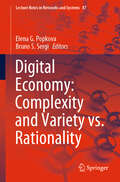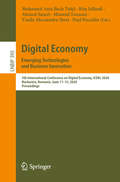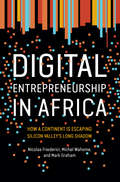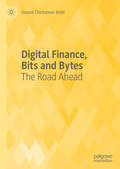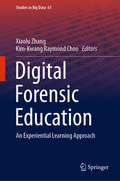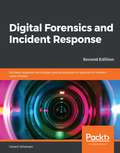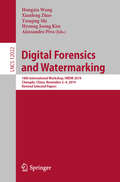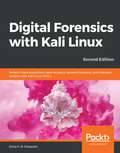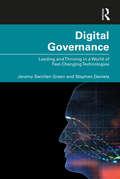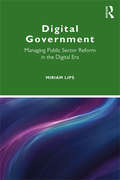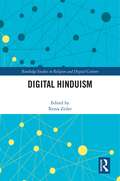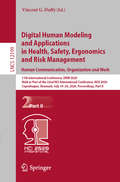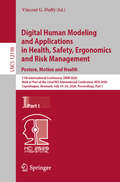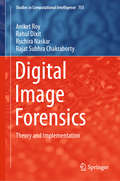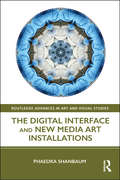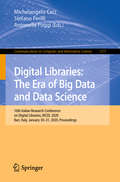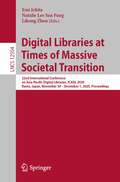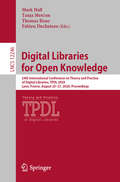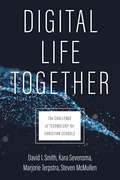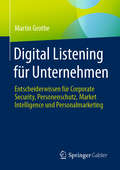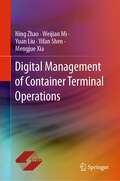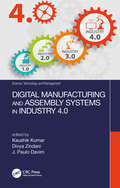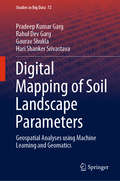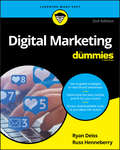- Table View
- List View
Digital Economy: Complexity and Variety vs. Rationality (Lecture Notes in Networks and Systems #87)
by Elena G. Popkova Bruno S. SergiThis proceedings book features selected papers from the 9th National Scientific and Practical Conference “Digital Economy: Complexity and Variety Vs. Rationality,” which took place on April 17–18, 2019, in Vladimir (Russian Federation). It presents the latest research in the field of the digital economy, discussing its role in the creation of advantages for the state, entrepreneurship, and society, as well as the emergence of new economic risks. The chapters address the following topics: the importance of economy’s digital modernization, tools for the formation of the digital economy in Russia, specific features and perspectives of digital modernization of the regional economy, an overview of the social consequences of transition to the digital economy, financial components of the digital economy, legal challenges regarding the digital reality for society and state, and the main challenges and threats to the profession of jurisprudence in the context of the digitization of the economy. Intended for representatives of the academic community and researchers interested in the formation of the digital economy and digital society as well as undergraduates, postgraduates, and masters of economic specialties, the book is also a valuable resource for companies that use or wishing to implement digital technologies into their economic practices; and public and government employees involved with monitoring, control, and regulation of the digital economy.
Digital Economy. Emerging Technologies and Business Innovation: 5th International Conference on Digital Economy, ICDEc 2020, Bucharest, Romania, June 11–13, 2020, Proceedings (Lecture Notes in Business Information Processing #395)
by Mohamed Anis Bach Tobji Rim Jallouli Ahmed Samet Mourad Touzani Vasile Alecsandru Strat Paul PocatiluThis book constitutes the refereed proceedings of the 5th International Conference, ICDEc 2020, held in Bucharest, Romania, in June 2020. Due to the COVID-19 pandemic the conference took place virtually. The 13 full papers presented in this volume together with 3 abstracts of keynotes and 1 introductory paper by the steering committee were carefully reviewed and selected from a total of 41 submissions. The core theme of this year’s conference was “Emerging Technologies & Business Innovation”. The papers were organized in four topical sections named: digital transformation, data analytics, digital marketing, and digital business models.
Digital Entrepreneurship in Africa: How a Continent Is Escaping Silicon Valley’s Long Shadow
by Nicolas Friederici Michel Wahome Mark GrahamThe hope and hype about African digital entrepreneurship, contrasted with the reality on the ground in local ecosystems.In recent years, Africa has seen a digital entrepreneurship boom, with hundreds of millions of dollars poured into tech cities, entrepreneurship trainings, coworking spaces, innovation prizes, and investment funds. Politicians and technologists have offered Silicon Valley-influenced narratives of boundless opportunity and exponential growth, in which internet-enabled entrepreneurship allows Africa to "leapfrog" developmental stages to take a leading role in the digital revolution. This book contrasts these aspirations with empirical research about what is actually happening on the ground. The authors find that although the digital revolution has empowered local entrepreneurs, it does not untether local economies from the continent's structural legacies.
Digital Finance, Bits and Bytes: The Road Ahead
by Vasant Chintaman JoshiThe book encompasses the broad field of e-Finance and its transformation. After reviewing the developments in the economic and the technology fields, it examines how the insurance, banking, and securities trading firms are bringing about the digital revolution and adapting in the same breath to the changed socio-economic environment. Add to it, the “Rogue Elements”, the field of cyber crimes is covered on a priority basis. The book also covers the inevitable changes in fields of HR and Marketing and the crucial role of the regulators. Looked at through the eyes of Corporate Planner, the book does provide a road map for the financial institutions (FIs).
Digital Forensic Education: An Experiential Learning Approach (Studies in Big Data #61)
by Xiaolu Zhang Kim-Kwang Raymond ChooIn this book, the editors explain how students enrolled in two digital forensic courses at their institution are exposed to experiential learning opportunities, where the students acquire the knowledge and skills of the subject-matter while also learning how to adapt to the ever-changing digital forensic landscape. Their findings (e.g., forensic examination of different IoT devices) are also presented in the book. Digital forensics is a topic of increasing importance as our society becomes “smarter” with more of the “things” around us been internet- and inter-connected (e.g., Internet of Things (IoT) and smart home devices); thus, the increasing likelihood that we will need to acquire data from these things in a forensically sound manner. This book is of interest to both digital forensic educators and digital forensic practitioners, as well as students seeking to learn about digital forensics.
Digital Forensics and Incident Response: Incident response techniques and procedures to respond to modern cyber threats, 2nd Edition
by Gerard JohansenBuild your organization's cyber defense system by effectively implementing digital forensics and incident management techniques Key Features Create a solid incident response framework and manage cyber incidents effectively Perform malware analysis for effective incident response Explore real-life scenarios that effectively use threat intelligence and modeling techniques Book Description An understanding of how digital forensics integrates with the overall response to cybersecurity incidents is key to securing your organization's infrastructure from attacks. This updated second edition will help you perform cutting-edge digital forensic activities and incident response. After focusing on the fundamentals of incident response that are critical to any information security team, you'll move on to exploring the incident response framework. From understanding its importance to creating a swift and effective response to security incidents, the book will guide you with the help of useful examples. You'll later get up to speed with digital forensic techniques, from acquiring evidence and examining volatile memory through to hard drive examination and network-based evidence. As you progress, you'll discover the role that threat intelligence plays in the incident response process. You'll also learn how to prepare an incident response report that documents the findings of your analysis. Finally, in addition to various incident response activities, the book will address malware analysis, and demonstrate how you can proactively use your digital forensic skills in threat hunting. By the end of this book, you'll have learned how to efficiently investigate and report unwanted security breaches and incidents in your organization. What you will learn Create and deploy an incident response capability within your own organization Perform proper evidence acquisition and handling Analyze the evidence collected and determine the root cause of a security incident Become well-versed with memory and log analysis Integrate digital forensic techniques and procedures into the overall incident response process Understand the different techniques for threat hunting Write effective incident reports that document the key findings of your analysis Who this book is for This book is for cybersecurity and information security professionals who want to implement digital forensics and incident response in their organization. You will also find the book helpful if you are new to the concept of digital forensics and are looking to get started with the fundamentals. A basic understanding of operating systems and some knowledge of networking fundamentals are required to get started with this book.
Digital Forensics and Watermarking: 18th International Workshop, IWDW 2019, Chengdu, China, November 2–4, 2019, Revised Selected Papers (Lecture Notes in Computer Science #12022)
by Hyoung Joong Kim Alessandro Piva Hongxia Wang Xianfeng Zhao Yunqing ShiThe 22 full papers and 12 shorts papers presented in this volume were carefully reviewed and selected from 70 submissions. The contributions are covering the following topics: deep learning for multimedia security; digital forensics and anti-forensics; digital watermarking; information hiding; steganography and steganalysis; authentication and security.
Digital Forensics with Kali Linux: Perform data acquisition, data recovery, network forensics, and malware analysis with Kali Linux, 2nd Edition
by Shiva V. ParasramTake your forensic abilities and investigation skills to the next level using powerful tools that cater to all aspects of digital forensic investigations, right from hashing to reporting Key Features Perform evidence acquisition, preservation, and analysis using a variety of Kali Linux tools Use PcapXray to perform timeline analysis of malware and network activity Implement the concept of cryptographic hashing and imaging using Kali Linux Book Description Kali Linux is a Linux-based distribution that's widely used for penetration testing and digital forensics. It has a wide range of tools to help for digital forensics investigations and incident response mechanisms. This updated second edition of Digital Forensics with Kali Linux covers the latest version of Kali Linux and The Sleuth Kit. You'll get to grips with modern techniques for analysis, extraction, and reporting using advanced tools such as FTK Imager, hex editor, and Axiom. Updated to cover digital forensics basics and advancements in the world of modern forensics, this book will also delve into the domain of operating systems. Progressing through the chapters, you'll explore various formats for file storage, including secret hiding places unseen by the end user or even the operating system. The book will also show you how to create forensic images of data and maintain integrity using hashing tools. Finally, you'll cover advanced topics such as autopsies and acquiring investigation data from networks, operating system memory, and quantum cryptography. By the end of this book, you'll have gained hands-on experience of implementing all the pillars of digital forensics: acquisition, extraction, analysis, and presentation, all using Kali Linux tools. What you will learn Get up and running with powerful Kali Linux tools for digital investigation and analysis Perform internet and memory forensics with Volatility and Xplico Understand filesystems, storage, and data fundamentals Become well-versed with incident response procedures and best practices Perform ransomware analysis using labs involving actual ransomware Carry out network forensics and analysis using NetworkMiner and other tools Who this book is for This Kali Linux book is for forensics and digital investigators, security analysts, or anyone interested in learning digital forensics using Kali Linux. Basic knowledge of Kali Linux will be helpful to gain a better understanding of the concepts covered.
Digital Governance: Leading and Thriving in a World of Fast-Changing Technologies
by Jeremy Swinfen Green Stephen DanielsDigital Governance provides managers with a simple and jargon-free introduction to the impact that digital technology can have on the governance of their organisations. Digital technology is at the heart of any enterprise today, changing business processes and the way we work. But this technology is often used inefficiently, riskily or inappropriately. Worse perhaps, many organisational leaders fail to grasp the opportunities it offers and thus fail to "transform" their organisations through the use of technology. This book provides an explanation of the basic issues around the opportunities and risks associated with digital technology. It describes the role that digital technology can play across organisations (and not just behind the locked doors of the IT department), giving boards and top management the insight to develop strategies for investing in and exploiting digital technology as well as arming them with the knowledge required to ask the right questions of specialists and to detect when the answers given are evasive or irrelevant. International in its scope, this essential book covers the fundamental principles of digital governance such as leadership, capability, accountability for value creation and transparency of reporting, integrity and ethical behaviour.
Digital Government: Managing Public Sector Reform in the Digital Era (Routledge Masters in Public Management)
by Miriam LipsDigital Government: Managing Public Sector Reform in the Digital Era presents a public management perspective on digital government and technology-enabled change in the public sector. It incorporates theoretical and empirical insights to provide students with a broader and deeper understanding of the complex and multidisciplinary nature of digital government initiatives, impacts and implications. The rise of digital government and its increasingly integral role in many government processes and activities, including overseeing fundamental changes at various levels across government, means that it is no longer perceived as just a technology issue. In this book Miriam Lips provides students with practical approaches and perspectives to better understand digital government. The text also explores emerging issues and barriers as well as strategies to more effectively manage digital government and technology-enabled change in the public sector. Digital Government is the ideal book for postgraduate students on courses in public administration, public management, public policy, political science and international relations, and e-government. It is also suitable for public service managers who are experiencing the impact of digital technology and data in the public sector.
Digital Hinduism (Routledge Studies in Religion and Digital Culture)
by Xenia ZeilerDigital Religion does not simply refer to religion as it is carried out online, but more broadly studies how digital media interrelate with religious practice and belief. This collection explores Digital Hinduism and consequentially studies how Hinduism is expressed in the digital sphere and how Hindus utilise digital media. Highlighting digital Hinduism and including case studies with foci on India, Asia and the global Hindu diaspora, this book features contributions from an interdisciplinary and international panel of academics. The chapters focus on specific case studies, which in summary exemplify the wide variety and diversity of what constitutes Digital Hinduism today. Applying methods and research questions from various disciplinary backgrounds appropriate to the study of religion and digital culture, such as Religious Studies, South Asian Studies, Anthropology and Media and Communication Studies, this book is vital reading for any scholar interested in the relationship between religion and the digital world.
Digital Human Modeling and Applications in Health, Safety, Ergonomics and Risk Management. Human Communication, Organization and Work: 11th International Conference, DHM 2020, Held as Part of the 22nd HCI International Conference, HCII 2020, Copenhagen, Denmark, July 19–24, 2020, Proceedings, Part II (Lecture Notes in Computer Science #12199)
by Vincent G. DuffyThis two-volume set LNCS 12198 and 12199 constitutes the thoroughly refereed proceedings of the 11th International Conference on Digital Human Modeling and Applications in Health, Safety, Ergonomics and Risk Management, DHM 2020, which was supposed to be held as part of the 22st HCI International Conference, HCII 2020, in Copenhagen, Denmark, in July 2020. The conference was held virtually due to the COVID-19 pandemic. A total of 1439 papers and 238 posters have been carefully reviewed and accepted for publication in HCII 2020. DHM 2020 includes a total of 77 papers; they were organized in topical sections named: Part I, Posture, Motion and Health: Posture and motion modelling in design; ergonomics and occupational health; applications for exercising, physical therapy and rehabilitation; health services; DHM for aging support. Part II, Human Communication, Organization and Work: Modelling human communication; modelling work, collaboration and the human environment; addressing ethical and societal challenges; new research issues and approaches in digital human modelling.
Digital Human Modeling and Applications in Health, Safety, Ergonomics and Risk Management. Posture, Motion and Health: 11th International Conference, DHM 2020, Held as Part of the 22nd HCI International Conference, HCII 2020, Copenhagen, Denmark, July 19–24, 2020, Proceedings, Part I (Lecture Notes in Computer Science #12198)
by Vincent G. DuffyThis two-volume set LNCS 12198 and 12199 constitutes the thoroughly refereed proceedings of the 11th International Conference on Digital Human Modeling and Applications in Health, Safety, Ergonomics and Risk Management, DHM 2020, which was supposed to be held as part of the 22st HCI International Conference, HCII 2020, in Copenhagen, Denmark, in July 2020. The conference was held virtually due to the COVID-19 pandemic. A total of 1439 papers and 238 posters have been carefully reviewed and accepted for publication in HCII 2020. DHM 2020 includes a total of 77 papers; they were organized in topical sections named: Part I, Posture, Motion and Health: Posture and motion modelling in design; ergonomics and occupational health; applications for exercising, physical therapy and rehabilitation; health services; DHM for aging support. Part II, Human Communication, Organization and Work: Modelling human communication; modelling work, collaboration and the human environment; addressing ethical and societal challenges; new research issues and approaches in digital human modelling.
Digital Image Forensics: Theory and Implementation (Studies in Computational Intelligence #755)
by Aniket Roy Rahul Dixit Ruchira Naskar Rajat Subhra ChakrabortyThis book discusses blind investigation and recovery of digital evidence left behind on digital devices, primarily for the purpose of tracing cybercrime sources and criminals. It presents an overview of the challenges of digital image forensics, with a specific focus on two of the most common forensic problems. The first part of the book addresses image source investigation, which involves mapping an image back to its camera source to facilitate investigating and tracing the source of a crime. The second part of the book focuses on image-forgery detection, primarily focusing on “copy-move forgery” in digital images, and presenting effective solutions to copy-move forgery detection with an emphasis on additional related challenges such as blur-invariance, similar genuine object identification, etc. The book concludes with future research directions, including counter forensics. With the necessary mathematical information in every chapter, the book serves as a useful reference resource for researchers and professionals alike. In addition, it can also be used as a supplementary text for upper-undergraduate and graduate-level courses on “Digital Image Processing”, “Information Security”, “Machine Learning”, “Computer Vision” and “Multimedia Security and Forensics”.
The Digital Interface and New Media Art Installations (Routledge Advances in Art and Visual Studies)
by Phaedra ShanbaumThis book is about the digital interface and its use in interactive new media art installations. It examines the aesthetic aspects of the interface through a theoretical exploration of new media artists, who create, and tactically deploy, digital interfaces in their work in order to question the socio-cultural stakes of a technology that shapes and reshapes relationships between humans and non-humans. In this way, it shows how use of the digital interface provides us with a critical framework for understanding our relationship with technology.
Digital Libraries: 16th Italian Research Conference on Digital Libraries, IRCDL 2020, Bari, Italy, January 30–31, 2020, Proceedings (Communications in Computer and Information Science #1177)
by Stefano Ferilli Michelangelo Ceci Antonella PoggiThis book constitutes the thoroughly refereed proceedings of the 16th Italian Research Conference on Digital Libraries, IRCDL 2020, held in Bari, Italy, in January 2020.The 12 full papers and 6 short papers presented were carefully selected from 26 submissions. The papers are organized in topical sections on information retrieval, bid data and data science in DL; cultural heritage; open science.
Digital Libraries at Times of Massive Societal Transition: 22nd International Conference on Asia-Pacific Digital Libraries, ICADL 2020, Kyoto, Japan, November 30 – December 1, 2020, Proceedings (Lecture Notes in Computer Science #12504)
by Lihong Zhou Emi Ishita Natalie Lee San PangThis book constitutes the refereed proceedings of the 22nd International Conference on Asia-Pacific Digital Libraries, ICADL 2020, which was planned to be held in Kyoto, Japan, in November/December 2020, but it was held virtually due to the COVID-19 pandemic.The 10 full, 15 short, 4 practitioners, and 10 work-in-progress papers presented in this volume were carefully reviewed and selected from 79 submissions. The papers were organized in topical sections named: natural language processing; knowledge structures; citation data analysis; user analytics; application of cultural and historical data; social media; metadata and infrastructure; and scholarly data mining.
Digital Libraries for Open Knowledge: 24th International Conference on Theory and Practice of Digital Libraries, TPDL 2020, Lyon, France, August 25–27, 2020, Proceedings (Lecture Notes in Computer Science #12246)
by Mark Hall Tanja Merčun Thomas Risse Fabien DuchateauThis book constitutes the proceedings of the 24th International Conference on Theory and Practice of Digital Libraries, TPDL 2020, held in Lyon, France, in August 2020.*The 14 full papers and 4 short papers presented were carefully reviewed and selected from 53 submissions. TPDL 2020 attempts to facilitate establishing connections and convergences between diverse research communities such as Digital Humanities, Information Sciences and others that could benefit from ecosystems offered by digital libraries and repositories. The papers present a wide range of the following topics: knowledge graphs and linked data; quality assurance in digital libraries; ontology design; user requirements and behavior; research data management and discovery; and digital cultural heritage. * The conference was held virtually due to the COVID-19 pandemic.
Digital Life Together: The Challenge of Technology for Christian Schools
by David I. Smith Steven McMullen Kara Sevensma Marjorie TerpstraDigital technologies loom large in the experience of today&’s students. However, parents, teachers, and school leaders have only started to take stock of the ramifications for teaching, learning, and faith. Based on a three-year in-depth study of Christian schools, Digital Life Together walks educators, school leaders, and parents through some of the big ideas that are hidden in our technology habits, going beyond general arguments for or against digital devices to address the nuanced realities of Christian education in a twenty-first-century context.
Digital Life Together: The Challenge of Technology for Christian Schools
by David I. Smith Kara Sevensma Marjorie Terpstra Steven McMullenDigital technologies loom large in the experience of today&’s students. However, parents, teachers, and school leaders have only started to take stock of the ramifications for teaching, learning, and faith. Based on a three-year in-depth study of Christian schools, Digital Life Together walks educators, school leaders, and parents through some of the big ideas that are hidden in our technology habits, going beyond general arguments for or against digital devices to address the nuanced realities of Christian education in a twenty-first-century context.
Digital Listening für Unternehmen: Entscheiderwissen für Corporate Security, Personenschutz, Market Intelligence und Personalmarketing
by Martin GrotheDieses Buch zeigt für Entscheider auf, wie Unternehmen die Inhalte im digitalen Raum erschließen und so ihre Sicherheit und Wettbewerbsposition entscheidend stärken. Digital Listening heißt, das Internet als Meinungs- und Informationsraum ernst zu nehmen und durch qualifizierte Analysen die eigene Sicht zu verbessern.Martin Grothe erklärt mit einem durchgängigen Prozessleitfaden sowie den notwendigen Hintergründen und Tools, wie Sie mit Digital Listening Ihr Sicherheitslagebild, eine Früherkennung von Bedrohungen, die Zielgruppenkommunikation, das Personalmarketing sowie den Schutz exponierter Persönlichkeiten wegweisend ausbauen.Führungskräfte erhalten Einblicke in mehrere Fachbereiche, aber auch den notwendigen Überblick: Sie finden einen strukturierten Zugang zu verfügbaren Tools, blicken in das Darknet, nehmen Reporting-Formate als Vorlagen auf, schlüpfen in die Rolle der dunklen Seite, hören Influencern zu und deklinieren einen Strategiefahrplan zum Engagement-Aufbau als Arbeitgeber durch. Wer Entwicklungen früher erkennt, Kontexte genauer versteht und Kommunikation passgenauer formuliert, der kann die Zukunft aktiver gestalten.Aus dem Inhalt Sicherheit und Wettbewerb in digitalen Zeiten: Digital Listening und die dunkle SeiteIntelligence Cycle: Vorgehen und Tools (Open Source, Advanced)Unternehmenssicherheit: Desinformation, Data-Breaches und der G20-CasePersonenschutz: Angriffsvektoren und SichtbarkeitsanalysenMarket Intelligence: Personalmarketing, Influencer, AI, CounterintelligenceGestaltungsaufgabe für das Management: Integration und AusblickViele Case Studies und Skizzen mit konkreten EinsatzszenarienMit Gastbeiträgen vonHeinz-Werner Aping (Direktor beim BKA a.D.)Prof. Dr. Peter Gentsch (Intelligence Group)Friedrich Christian Haas (AKE Group)Jerry Hoffmann (Counteraction)Udo Hohlfeld (INFO + DATEN)Samira Mousa (healthy content)Chris West (Counteraction)Klaus Pfeifer (Pinkerton)
Digital Management of Container Terminal Operations
by Ning Zhao Yuan Liu Weijian Mi Yifan Shen Mengjue XiaThis book presents a comprehensive study on intelligent container terminals. Based on the development experience gained to date with container terminals, it analyzes information flows and their interactions with container terminals; illustrates the operation management process from information collection to resource planning and from equipment scheduling to field operation; highlights several dynamic decision-making problems concerning digital operation processes and container terminals; reveals the basis of the discrete logistics system; and discusses the future of intelligent container terminals.
Digital Manufacturing and Assembly Systems in Industry 4.0 (Science, Technology, and Management)
by Kaushik Kumar Divya Zindani J. Paulo DavimManufacturing, like other industries, is rising to the challenges imposed by aggressive consumer demands and the need for cost-effective processing that delivers quality in the fastest possible time. Fierce competition means that keeping abreast of new developments and applications in technology is essential if companies are to meet demands profitably and keep ahead of competitors. This book investigates the design and management of digital manufacturing and assembly systems for an efficient, flexible, and modular production of customized products using the I40 (industry 4.0)-enabling technologies. This book will also provide case studies covering modeling, simulation, and optimization. eBook includes color figures. Discusses how the advancement of data communication and storage through the Internet of Things (IoT) opens the possibilities of connecting sensors, robots, and devices Sheds light on how the human role in industry is decreasing due to the development of connected manufacturing floors, allowing them to take more control over the manufacturing processes, decisions, and even maintenance Covers the benefits from exploiting digital manufacturing, manufacturing enterprises, and what they expect to achieve Explains the important roles that modeling, simulation, and optimization play Investigates the design and management of digital manufacturing and assembly systems for an efficient, flexible, and modular production of customized products exploiting the I40 (industry 4.0)-enabling technologies
Digital Mapping of Soil Landscape Parameters: Geospatial Analyses using Machine Learning and Geomatics (Studies in Big Data #72)
by Pradeep Kumar Garg Rahul Dev Garg Gaurav Shukla Hari Shanker SrivastavaThis book addresses the mapping of soil-landscape parameters in the geospatial domain. It begins by discussing the fundamental concepts, and then explains how machine learning and geomatics can be applied for more efficient mapping and to improve our understanding and management of ‘soil’. The judicious utilization of a piece of land is one of the biggest and most important current challenges, especially in light of the rapid global urbanization, which requires continuous monitoring of resource consumption. The book provides a clear overview of how machine learning can be used to analyze remote sensing data to monitor the key parameters, below, at, and above the surface. It not only offers insights into the approaches, but also allows readers to learn about the challenges and issues associated with the digital mapping of these parameters and to gain a better understanding of the selection of data to represent soil-landscape relationships as well as the complex and interconnected links between soil-landscape parameters under a range of soil and climatic conditions. Lastly, the book sheds light on using the network of satellite-based Earth observations to provide solutions toward smart farming and smart land management.
Digital Marketing For Dummies
by Ryan Deiss Russ HenneberryGet digital with your brand today! Digital Marketing for Dummies has the tools you need to step into the digital world and bring your marketing process up to date. In this book, you’ll discover how digital tools can expand your brand’s reach and help you acquire new customers. Digital marketing is all about increasing audience engagement, and the proven strategy and tactics in this guide can get your audience up and moving! You’ll learn how to identify the digital markets and media that work best for your business—no wasting your time or money! Discover how much internet traffic is really worth to you and manage your online leads to convert web visitors into paying clients. From anonymous digital prospect to loyal customer—this book will take you through the whole process! Learn targeted digital strategies for increasing brand awareness Determine the best-fit online markets for your unique brand Access downloadable tools to put ideas into action Meet your business goals with proven digital tactics Digital marketing is the wave of the business future, and you can get digital with the updated tips and techniques inside this book!
